[one_half]
Day 1 – Arrive in Edinburgh
Welcome to Scotland!
Your private coach will meet you at the Edinburgh airport and together you will drive (1h) to North Berwick. You have no golf planned today – you might like a visit to the spa, after such a long journey.
* * * * * * * * * * * * * * * * *
Your Hotel:
Greywalls Hotel
Greywalls, Muirfield, Gullane, East Lothian EH31 2EG
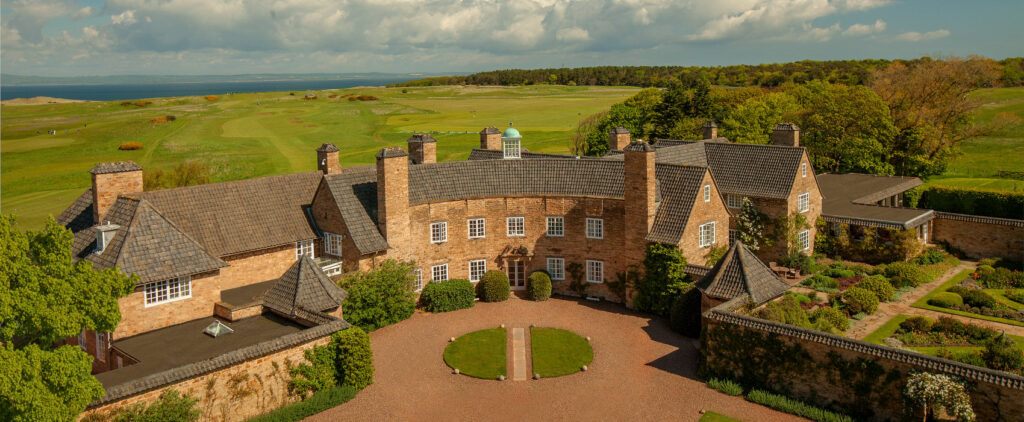 A favourite amongst the world’s golfing elite, Greywalls overlooks the 9th green and the 10th tee of Muirfield, one of the most famous golf courses in the world. With a fine reputation for great food, great wines and great service (with trademark Scottish friendliness), Greywalls offers the perfect location for a relaxing break in one of Scotland’s best country house hotels.
A favourite amongst the world’s golfing elite, Greywalls overlooks the 9th green and the 10th tee of Muirfield, one of the most famous golf courses in the world. With a fine reputation for great food, great wines and great service (with trademark Scottish friendliness), Greywalls offers the perfect location for a relaxing break in one of Scotland’s best country house hotels.
Greywalls was designed by renowned British Architect Sir Edwin Lutyens in 1901. Lutyens is famous for being the principal architect for those famous English country homes at the turn of the 19th century (the likes of which you’ve probably seen in historical dramas) and this house is the only example of Lutyens’ work remaining in Scotland. Greywalls has been in the same family since 1924, with portraits of relatives on the walls, antiques in the homely bedrooms and even a collection of school caps hanging from the antlers over the staircase, this is an intimate country house hotel whose owner’s wife still overseas some aspects of the hotel’s grounds.
A unique country house with lots of character in a remarkable setting, Greywalls provides a memorable venue in which to unwind after a long day of golf.
Day 2 – Play Gullane #1
Today, you’ll have a mid-morning round at the unique Gullane #1, the home of the Scottish Open this year (2018) and an annual Open Qualifying course. #1 Course is also an extremely picturesque course with stunning views of the Firth of Forth from the course.
* * * * * * * * * * * * * * * * *
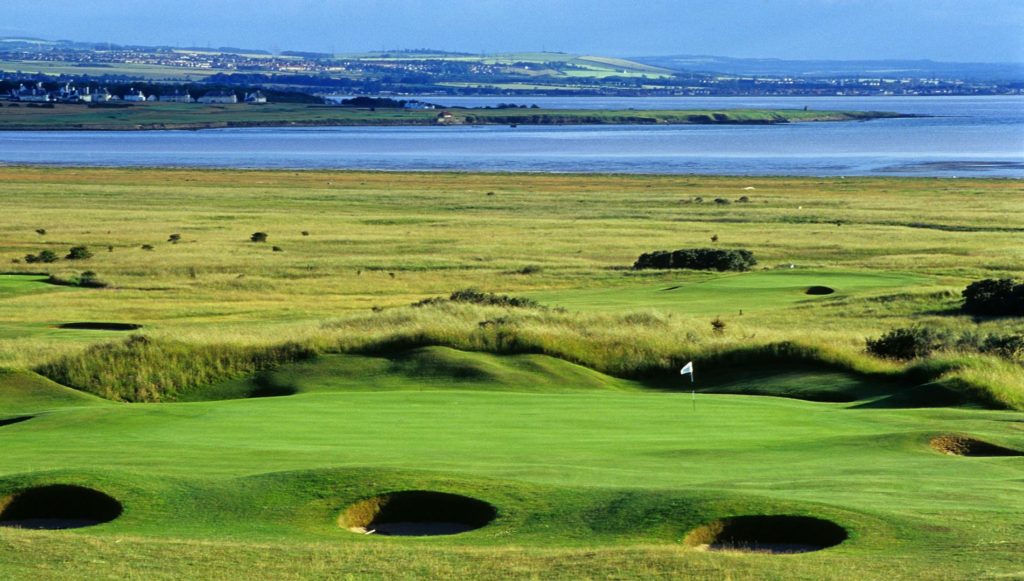
Gullane Golf Club
Course No.1 is one of three courses at Gullane Golf Club. The No.1 course was laid down in 1884, yet no one knows who designed it, so like the Old Course it is often attributed to Mother Nature. Gullane is blessed with the most exquisite turf – winter rules are not needed here.If you hit the fairways, a perfect lie awaits, even in the depths of winter.The opening hole, cunningly called First, is a relatively gentle short par four. The 2nd hole, called Windygate, begins the march up Gullane Hill. The 3rd hole is called Racecourse, a short par five which plays along what was once an old 18th century racecourse and it continues to take you onwards and upwards, now at a canter, until you reach the 7th tee and the 200ft summit of Gullane Hill. The 360-degree views from the vantage point of the 7th tee are simply breathtaking. In the foreground, all around, are the fluttering flags of Gullane and Muirfield. The Lammermuir Hills lie to the south, while the Firth of Forth wraps up the panorama to the north, west and east.
There is a great requirement for varied uphill and downhill shot-making. This in itself is quite unusual for a links course and makes Gullane all the more fascinating.
There is a full-length practice ground next to the Visitors’ Clubhouse. You received a bucket of balls with your green fees. There is also a short game area for you to practice putting, chipping and bunker shots.
Course Fast Facts:
Yards: 6873
Year Founded: 1882
Designer(s): Mother Nature!
Day 3 – Play North Berwick
Today you will have the immense pleasure of playing the quirky and delightful North Berwick, a perennial World Top 100.
* * * * * * * * * * * * * * * * *
 New Club House, Beach Rd, North Berwick
New Club House, Beach Rd, North Berwick
The West Links at North Berwick Golf Club is an immensely enjoyable golf course, located on the Firth of Forth with stunning sea views across to Craigleith Island and Bass Rock. The equivalent of Turnberry’s “Ailsa Craig”, Bass Rock is a huge volcanic lump, rising up over 300 feet from the Firth of Forth. It’s the closest seabird sanctuary to the mainland and home to 80,000 nest sites; approximately 10 per cent of the world’s population of Atlantic Gannets stay here.
This is a course that is extremely close to the origins of golf. It’s the thirteenth oldest golf club (founded in 1832) and the third oldest course in the world still playing over its original fairways. Only St Andrews (Old) and Musselburgh (Old) are more senior.
The original architect is unknown. We do know that North Berwick started out in life as a 6-hole course and was extended to 18 holes by 1877. Around the turn of the 19th century the course was stretched out to a little over 6,400 yards. There are two reasons why North Berwick is such an enjoyable course: 1) the land is raised above sea level, affording those excellent views 2) it has a superb collection of holes, a number of which have been replicated at other courses the world over (what other golf course has a small wall protecting the green, see image of #13).
The 15th is one of the world’s most famous holes. It’s a par 3 measuring 190 yards, called “Redan” (a military term meaning “guarding parapet”), and is the most copied hole. Bernard Darwin referred to this hole in his book, Golf Courses of the British Isles: “a beautiful one shot hole atop a plateau with a bunker short of the green, to the left, and another further on to the right, and we must vary our mode of attack according to the wind, playing a shot to come in from the right or making a direct frontal attack”.
One of the many beauties of North Berwick is that you can play the course without being punished brutally by penal rough. They like a round to take no more than three hours and consequently, the rough is kept relatively short to speed up play. It’s not the longest links course in the world but it’s sheer fun and a unique experience to boot. You’ll need to negotiate stonewalls, deep bunkers, all kinds of humps and hollows and burns. You’ll need to hit blind shots and you’ll need to hit shots out over the beach. Very fun stuff.
Course Fast Facts:
Yards: 6,500
Year Founded: 1832
Designer(s): Original designer is unknown!
Day 4 – Play Muirfield
A one day membership to “The Honourable Company of Edinburgh Golfers” starts with 18 holes (you’ll be starting from the 10th tee), then you’ll shower and change into your jacket and tie for a lovely lunch. After golf, it is on to the Home of Golf, St Andrews.
* * * * * * * * * * * * * * * * *
Duncur Rd, Muirfield, Gullane, East Lothian
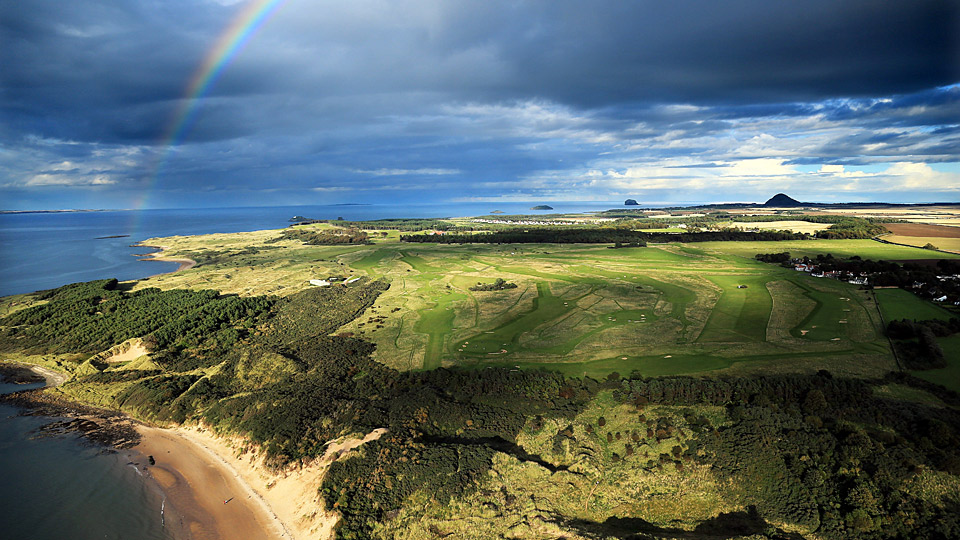 Many of the worlds greatest players believe that Muirfield is the fairest examination of championship golf among all the great and historic course of the British Isles. Muirfield is the course of “The Honourable Company of Edinburgh Golfers” (HCEG), the world’s oldest golf club according to direct written evidence formed in 1744. Originally designed as a 16-hole course by Old Tom Morris, the Muirfield course officially opened in 1891. A further two holes were added a few months later. In 1928, Harry Colt and Tom Simpson were brought in to make alterations to the layout.
Many of the worlds greatest players believe that Muirfield is the fairest examination of championship golf among all the great and historic course of the British Isles. Muirfield is the course of “The Honourable Company of Edinburgh Golfers” (HCEG), the world’s oldest golf club according to direct written evidence formed in 1744. Originally designed as a 16-hole course by Old Tom Morris, the Muirfield course officially opened in 1891. A further two holes were added a few months later. In 1928, Harry Colt and Tom Simpson were brought in to make alterations to the layout.
Over the winters of 2010 and 2011, changes were made at fifteen holes following a review by Martin Hawtree to ensure that Muirfield remained a suitable challenge for the world’s best professional and amateur golfers. In summary those changes included the introduction of new bunkers in selected drive areas; the relocation of greenside bunkers to tighten the entrances to greens; the extension of greens to provide more championship pin positions and the introduction of six new championship tees taking the course to 7245 yards in length. While many in number, the changes were subtle in nature and the essential characteristic of Muirfield has been carefully retained.
Course Fast Facts:
Yards: 7,245
Year Founded: 1744
Designer(s): Old Tom Morris
* * * * * * * * * * * * * * * * *
Your Hotel:
Old Course Hotel
Old Station Rd, St Andrews KY16, United Kingdom
Bordering the renowned 17th ‘Road Hole’ of the Old Course in the Home of Golf, the Old Course Hotel enjoys a spectacular location overlooking the famous links courses, the West Sands beach and the beautiful Scottish coastline.
The Old Course Hotel offers an exceptional choice of bars and restaurants from the chic informality of the Sands Grill to the fine dining in the acclaimed Road Hole Fine Dining Restaurant (3 AA rosettes). In addition, the hotel’s traditional pub The Jigger Inn serves fine home-cooked food and The Duke’s Bar & Grill offers a traditional Scottish golfers’ menu. And our award winning Road Hole Bar offers Scotland’s finest malt whiskies from over 200 distilleries.
We recommend staying in an Old Course Room, which all have direct views of the Old Course.
Day 5 – Play Carnoustie
Today’s test is Car-Nasty, the home of The 2018 Open. Hopefully you have found your game by the time you arrive at Canoustie’s first tee.
* * * * * * * * * * * * * * * * *
Carnoustie
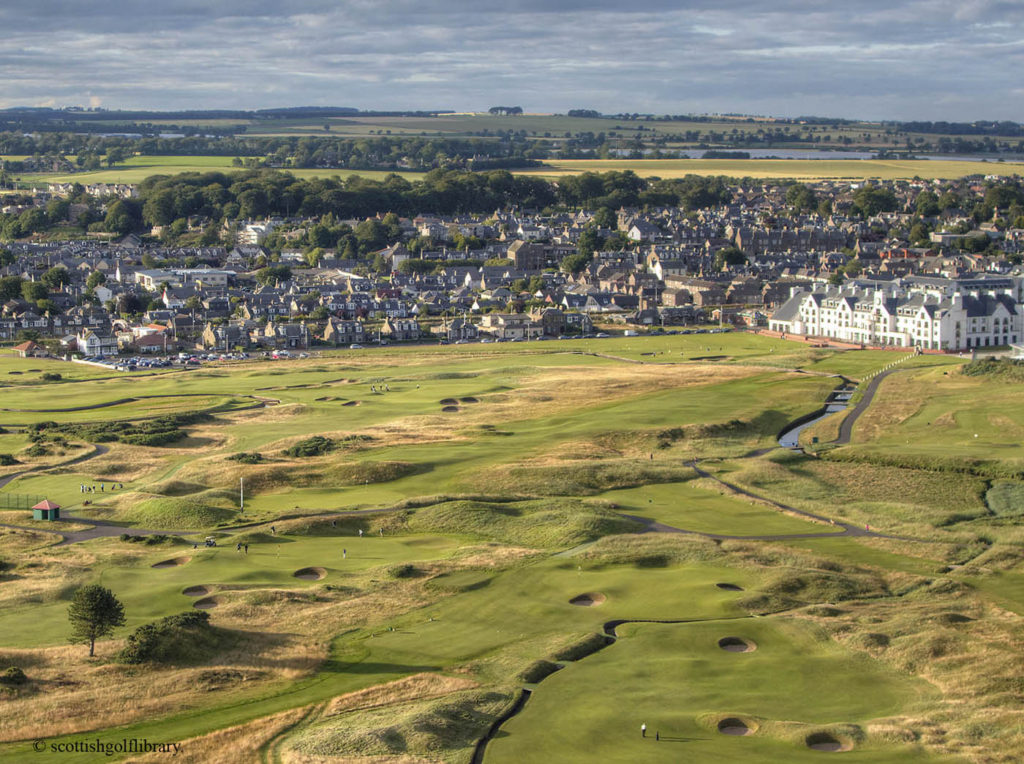 Links Parade, Carnoustie
Links Parade, Carnoustie
Carnoustie is a big natural seaside links and is widely considered to be one of the world’s most difficult golf courses. In fact, according to the results of a recent Top 100 survey, Carnoustie is the toughest golf course in Britain & Ireland.
The first record of golf being played across this links land dates back to 1527; a 10hole course was laid out in 1842. Fifteen years later, in 1857, an 18hole course was fashioned by Old Tom Morris. James Braid extended the course in 1926 and it has hardly changed since.
The initial challenge for the first time visitor to Carnoustie is locating the course. There are no signposts. You will have to negotiate a narrow railway tunnel and wind your way through dreary housing estates. But once you get on the first tee, you will begin to appreciate the scale of the challenge that faces you, and realize that finding the course was the easy bit!
Much has been written about Carnoustie over the years. The finishing holes are especially brutal at this seven-time Open Championship venue and many consider that it has one of the greatest back nines in championship golf. You have to cross the snaking burn no less than five times whilst playing the closing two holes.
Carnoustie isn’t the most scenic golf course – rarely do you catch glimpses of the sea – but it is incredibly tough, even from the forward tees. Bring your “A” game here, the don’t call it “Car-Nasty” for nothing.
Course Fast Facts:
Yards: 5,922
Year Founded: 1894
Designer(s): Old Tom Morris
Day 6 – Play Kingsbarns
Located just down the road from St Andrews, is Kingsbarns, yet another World Top 100 for you to conquer.
* * * * * * * * * * * * * * * * *
Kingsbarns
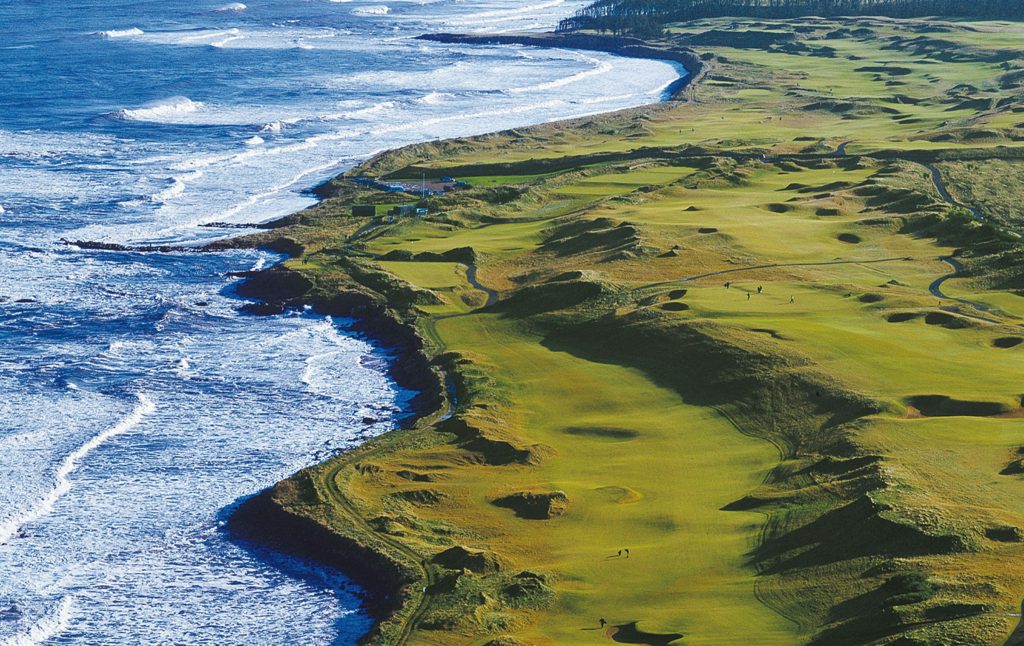 The first golden era of golf course design was in the 1920s when some of the best all time architects were alive and designing: Alister Mackenzie, Seth Raynor, A.W. Tillinghast, H.S. Colt and George Thomas. “The Roaring Twenties” were also a time of unprecedented global prosperity with markets booming around the world. Of the 100 top courses in the world an astonishing 28 are were built in the 1920s.
The first golden era of golf course design was in the 1920s when some of the best all time architects were alive and designing: Alister Mackenzie, Seth Raynor, A.W. Tillinghast, H.S. Colt and George Thomas. “The Roaring Twenties” were also a time of unprecedented global prosperity with markets booming around the world. Of the 100 top courses in the world an astonishing 28 are were built in the 1920s.
We are lucky to live in the new golden era of golf course architecture. Kingsbarns (ranked #65 in the world) is one of the new generation of courses that have graced the world in the 1990s and 2000s, specifically having been built in 1999. The new golden era is characterized by architects such as David Kidd, Tom Doak, Bill Coore and Ben Crenshaw and Kyle Phillips, the designer of Kingsbarns. This new group has designed many new courses that rank in the top 100. This new generation of world-ranked courses follows a dearth in good design.
The Kingsbarns Golf Links folks envisioned that someday their brand new golf course would take its place alongside St. Andrew’s Old Course, Crail Balcomie Course and some of the other great golf courses in the Kingdom of Fife and became a “must play.”
A nine-hole golf course once played over part of the current layout. The “nine-holer” was commandeered by the military at the outbreak of the Second World War because they felt that the beach at Kingsbarns was an invasion risk. The golf course disappeared until American architect Kyle Phillips came along at the close of the 20th century.
Course Fast Facts:
Yards: 7,181
Year Founded: 1793
Designer(s): Kyle Phillips
Day 7 – Play Old Course
A day in St Andrews, at the oldest golf course in the world. After your round, you’ll head into the fun town of Edinburgh, with a one night stay at The Principal.
* * * * * * * * * * * * * * * * *
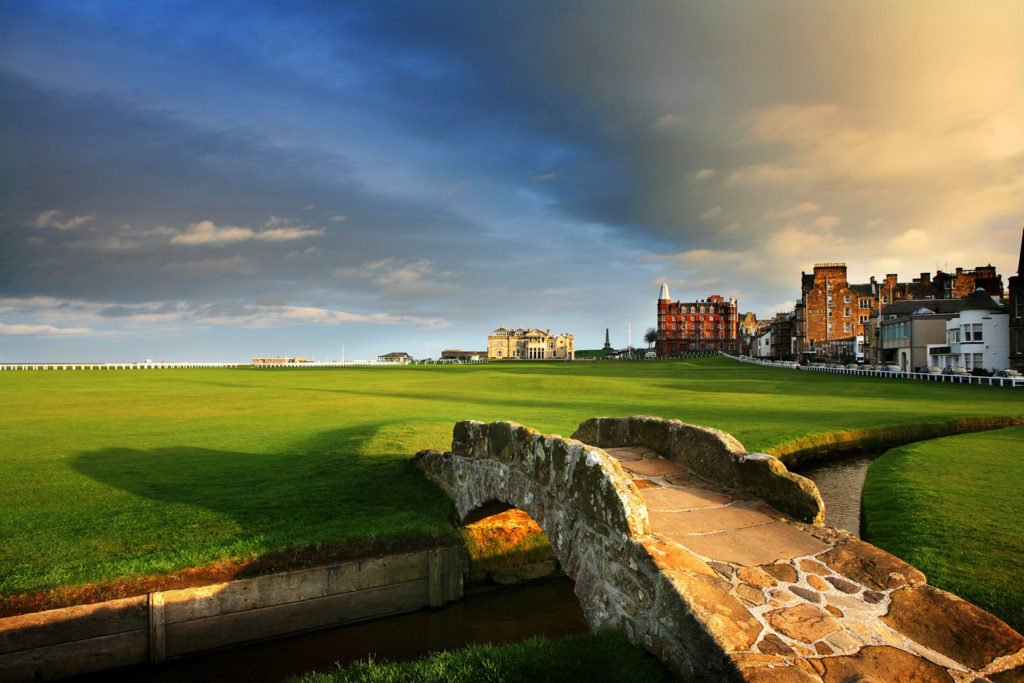 Rarely is the Old course ranked outside the top ten because it’s a very special links, designed by Mother Nature. Surely there is little left to write about St Andrews; the spiritual home of golf, the world’s most famous links course, the mother of golf and so on. It is probable that golf was played here way back in the 12th century; what is certain is that the Old course is one of the oldest golf courses in the world.
Rarely is the Old course ranked outside the top ten because it’s a very special links, designed by Mother Nature. Surely there is little left to write about St Andrews; the spiritual home of golf, the world’s most famous links course, the mother of golf and so on. It is probable that golf was played here way back in the 12th century; what is certain is that the Old course is one of the oldest golf courses in the world.
The St Andrews Old course itself usually isn’t an instant hit, it’s a golf course you have to get to know and love. First timers might be somewhat disappointed. It’s also unlikely that the Old course will feel familiar when you play it for the first time (except perhaps the 1st, 17th and 18th). Television pictures tend to make the ground look very flat – the humps, hollows and ripples in the fairways are much deeper when you get out onto the course, as indeed are the pot bunkers. Dr Alister MacKenzie wrote in his book, The Spirit of St Andrews: “A good golf course is like good music or anything else: it is not necessarily a course which appeals the first time one plays over it; but one which grows on a player the more frequently he visits it.”
And a word about the greens: they are the most extraordinary and interesting putting surfaces in the world. There is little definition between where the fairway, fringe and green stops or starts and the fairways are probably faster and certainly more undulating than the average golf club’s greens. And the size of them is absolutely staggering – they are gigantic, occupying more than an acre in some cases. When you are on the green, forget about having the pin tended – take a pair of binoculars instead.
Course Fast Facts:
Yards: 6,721
Year Founded: 1553
Designer(s): Mother Nature
* * * * * * * * * * * * * * * * *
Your Hotel: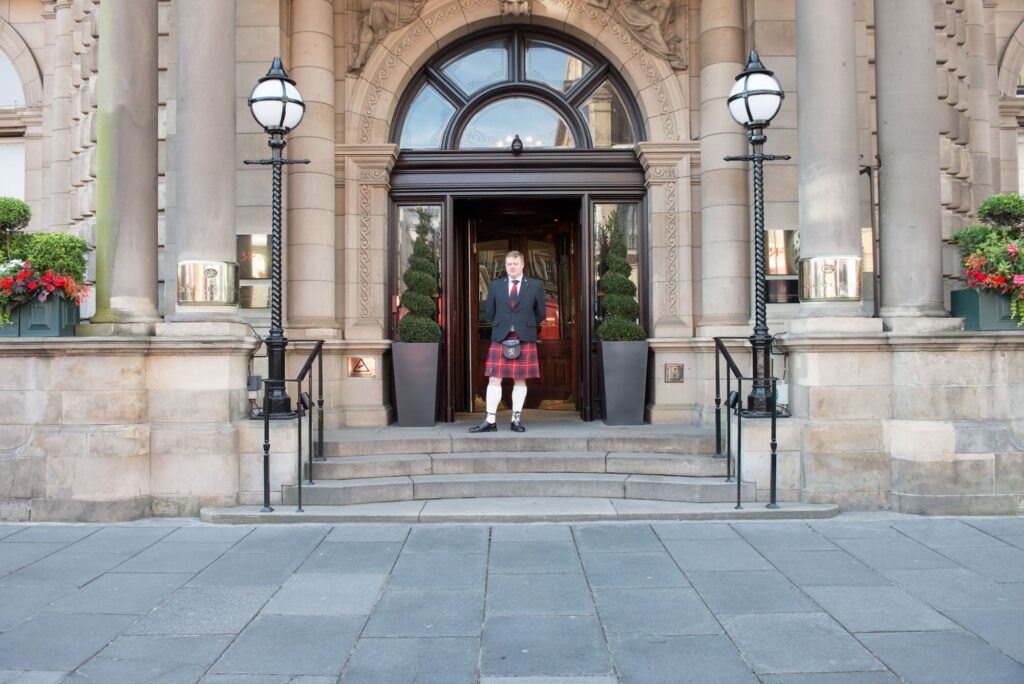
The Balmoral
1 Princes St, Edinburgh
The Balmoral is the grande dame in the very heart of Edinburgh. Previously a former railroad hotel, it is located below the landmark clock tower (on the east end of Princes Street).
The lively buzz in the surroundings makes you feel as if you’re at the centre of city life.
The design of the rooms were envisioned to embody the Scottish landscape, with a colour palette of blues and greys, bringing the country’s woodlands, heather-covered hills and lochs within the hotel’s walls. Many of the rooms add to the sublime sense of place with views out over Edinburgh Castle, Arthur’s Seat and the Old Town.
To put it over-the-top, the hotel’s main restaurant, Number One, is the only Michelin-starred restaurant in Edinburgh. Their whisky bar serves more than 400 malts and blends. And hey, if you overindulge, you can always recuperate at the luxurious spa.
Day 8 – Departure Day
After breakfast, your private mini-coach will take you to the Edinburgh Airport for the first leg of your journey home.
* * * * * * * * * * * * * * * * *
What’s Included
- 7 nights accommodation
- Breakfast each morning
- 6 rounds of golf
- North Berwick
- Gullane #1
- Muirfield (one round and lunch)
- Carnoustie
- Kingsbarns
- Old Course
- Chauffeur driven luxury minicoach replete with leather bucket chairs, tables, fridge, electrical outlets
- Services of Travel Impresarios Golf with custom trip booklet.